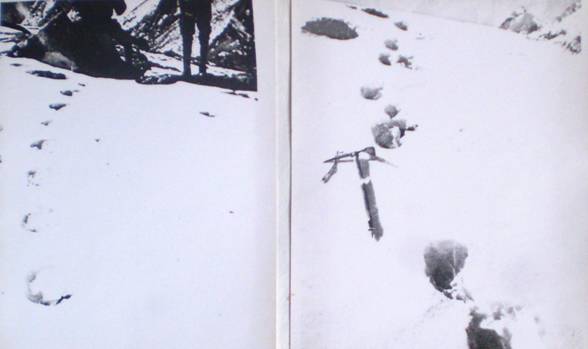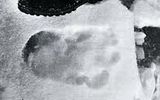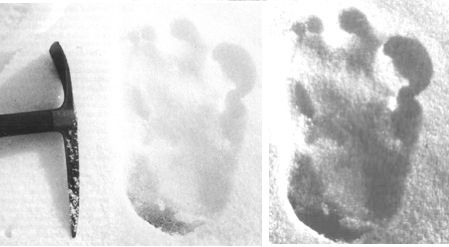Himalayan mountains tried to conquer many travelers. Often they were told that among the mountain hills in the snow, they were met by a huge evidence of an unknown creature.
The interest of the world community to the mysterious creature, now called Yeti, Bigfoot or Sasquatch, appeared shortly after the English mountain climbers Eric Shipton and Michael ward had photographed in 1951, the unfamiliar footprints in the snow of the Himalayan highlands.
For the sake of justice it is worth noting that they weren't the first climbers, who were told about the strange traces, and even not the first who managed to photograph them.
For example, in 1925 the Greek scholar A. N. Tamboti saw a strange creature near the pass, not To the North side of Kanchenjunga. He wrote:
“Taking out the binoculars, I looked in that direction. The first few seconds, blinded by the glare of the snow, I could not see. But then at a distance of 200-300 yards down I recognized the object that was referred to by the porters. Undoubtedly, the dark figure kept absolutely straight, occasionally bending down to dig up the roots of the dwarf rhododendrons. On the snowy background, it seemed dark and could not see any clothes. After about a minute, the creature walked into the thickets and disappeared. Later came at this place, I examined his tracks, shaped like a human, but only six or seven inches. Prints of five fingers and instep are clear, and the traces of the heel - is unclear....”
In 1937, the famous mountaineer sir John hunt, being on the North side of the pass, Qiemo (Eastern Nepal) at an altitude of 19 thousand feet, came across two sets of tracks, so similar to human that at first he had a suspicion, not visited by anyone all the way up to him. Later it was proved that at that time in this place anyone could be. Hunt managed to photograph traces.
The traces discovered by the expedition George.Hunt in 1937.
In 1948 in the same area two Norwegians from the Swiss expedition already told you that I tracked down two APE-like creatures on the trail, intending to catch them, but in the end themselves were attacked.
However, these were mere stories and not the most clear photos. In the case of Eric Shipton and Michael Ward the tracks were clear, which allowed them to measure and obtain quality photographs (see gallery). Judging by the size of the track, it was owned by a large creature: its length was 13 inches (33 cm), width 8 inches (20 cm). It was evident that the creature has left him, walked on two legs like a man. In the opinion of many climbers and scientists of the time, there are no known animals could not leave a trace.
Eric Shipton tells the following about the circumstances of obtaining that photo.
"It happened on one of the glaciers of the pool Menlung at an altitude of about 19000 ft ( 5800 m) in the second half of the day. We came across strange tracks in the snow, which then caused certain interest of the public in Britain. We followed them further than it was convenient for us, as it carried a large cargo. It was a mile or so. We also conducted a very interesting study of this basin. I have previously found many chains such unusual tracks, tried to follow them, but always lost them on the moraines or on the rocks in glaciers.
These tracks seemed particularly fresh, abandoned not more than 24 hours ago. When Murray and Bourdillon (the expedition) followed us a few days later, those marks were almost shapeless because of podawania snow. Sen Tenzig (Sherpa, a member of the expedition) had no doubt what creature belonged to these tracks (they could be of two types), they were the footprints of "Bigfoot", or "wild man"
This story is supplemented with interview Shipton later gave to the newspaper "daily mail".
"This photograph is particularly good,' said Shipton, since the trail imprinted on a thin layer of crystalline snow that lay on top of solid ice. So when the creature moved a leg forward, the trail is almost not distorted. Tracks, quite fresh, was abandoned, probably in just a few hours before we found them, and in any event on the same day.
They defended from one another by 75 inches and walked towards the crack. In the place where we came upon the traces, in all likelihood, traveled two creatures. It was at an altitude of about 5500 meters, significantly beyond the forest boundary. Tracks went some distance around, and then crossed. I did not mention so far that has paid special attention to the place where one of the creatures jumped through a crack width of about 90 centimetres. There could be seen a trace of impulse, and on the other side of a clear fingerprint, buried at landing in the snow. I wish I took a picture of the track on the other side cracks".
One of the most clear pictures subsequently often published in the media and was dubbed “the Trail of Shipton”.
The appearance of these photographs in the press had a question about excessive massiveness of the thumb. In V. Y. Makarov "Atlas "Bigfoot" claimed that the situation was explained to the Soviet climber, honored master of sports of Marecek, who said that he was well acquainted with Milton, and he admitted that this finger in the snow I could barely see and to photograph climbers “tweaked it a tin can”.
Undoubtedly, these pictures are repeatedly criticized, including for the above statements. After all, the author of the picture could alter not only the shape of the thumb, but the rest of the trail. The most popular versions of the appearance of these traces, in addition to the presence in the Himalayas unknown giant humanoids, considered intentional falsification and the overlap of the two traces of known creatures. For example, anthropologist John Napier claimed that this trail is the overlay prints on the front and rear paws of the snow leopard.
The version with the overlay of the two traces was also perceived by the supporters of the existence of Bigfoot. For example, she studies in some detail Trachtengerts M. S. in the article "the Himalayan E. Shipton, a new trace analysis", published in the journal "science and engineering" in 2003.
The author, relying on the approval of Shipton, in the place of receipt and the pictures were two sets of footprints from individuals, heading in the same direction, indicates that the above mentioned characteristics of track can be caused by the fact that he actually represents the superposition of the traces of two different individuals - the first snow came a larger instance, and then at that place put his foot specimen of a smaller size. To render his claim, he cites the following figure:
The author believes that the track dimensions of the smaller creatures the following: foot length 28 cm, width of heel 12cm, foot width at metatarsophalangeal joints 13.5 cm, and the length of the foot of the first being about 35 cm. the author Also notes that the unusual form of a thumbprint on the photo of Shipton happened because the first creature while lowering his feet into the snow she flexed her strong finger and stuck it in the snow, using as a hook. The second beast put his foot already on the compacted snow, and he no longer had to use his fingers in a similar way.
As a result, he concludes that the traces belong to two unknown to science beings: "the analysis removes doubts about the accessories of this trail unknown hominoid".
Or, for example, in the journal "Science and life" №10, 2014 stated "the Mysterious footprint was photographed in 1951 in the Himalayas by English mountaineer Eric Shipton, has long been considered a possible trace of the Yeti. Now it is proved that it melted in the sun track of a Himalayan bear." Although the link to the original scientific article, where we discover the question was not specified.
Despite the controversy surrounding this picture has long subsided, and the representatives of each camp perceive it differently to suit their own beliefs, it is undeniable that it was he who created the world popularity of the phenomenon of Bigfoot, laying the Foundation for not only cinematic history but also for further expeditions.
Translated by «Yandex.Translator»
The interest of the world community in the mysterious creatures, now called Yeti, Bigfoot or Bigfoot, appeared shortly after British climbers Eric Shipton and Michael Ward photographed unfamiliar footprints in the snow of the Himalayan Highlands in 1951. Although they were not the first climbers who told about the strange tracks, and not even the first who managed to photograph them
Log in or register to post comments











